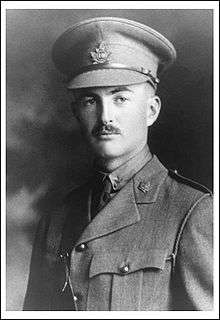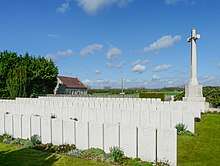Wallace Lloyd Algie
Wallace Lloyd Algie, VC (10 June 1891 – 11 October 1918) was a Canadian Army officer and a recipient of the Victoria Cross (VC), the highest award for gallantry in the face of the enemy that can be awarded to British and Commonwealth forces. A soldier with the Canadian Expeditionary Force during the First World War, he was posthumously awarded the VC for his actions on 11 October 1918, during the Hundred Days Offensive.
Wallace Lloyd Algie | |
|---|---|
 | |
| Born | 10 June 1891 Alton, Ontario, Canada |
| Died | 11 October 1918 (aged 27) Iwuy, France |
| Buried | Niagara Cemetery, Iwuy |
| Allegiance | Canada |
| Service/ | Canadian Army |
| Years of service | 1916–1918 † |
| Rank | Lieutenant |
| Unit | 20th (Central Ontario) Battalion |
| Battles/wars | First World War |
| Awards | Victoria Cross |
Early life
Wallace Lloyd Algie was born on 10 June 1891 at Alton in Ontario, Canada, the son of James and Rachel Algie. His father was a medical doctor whose practice covered Peel County, near Toronto. The family later moved to Toronto itself. Algie was educated at Alton Public School and when his schooling was completed, he worked in banking before entering the Royal Military College of Canada. After graduating as a lieutenant, he served initially in The Queen's Own Rifles of Canada and then the 40th Regiment.[1]
First World War
In April 1916, Algie enlisted in the Canadian Expeditionary Force, a brother having already volunteered to serve in the First World War. Initially posted to the 95th Battalion, he was later transferred to the 20th Battalion, which arrived in France the following year to join the 4th Canadian Infantry Brigade on the Western Front.[1] He took part in the Battle of Hill 70 and in the subsequent operations around Lens.[2]
On 11 October 1918, during the Hundred Days Offensive, the 4th Brigade was supporting the 6th Infantry Brigade in an attack on the German-held village of Iwuy, north east of Cambrai in France. Aware that German soldiers were bringing up more machine-guns, Algie led a group of volunteers past the battalion's designated area of operations and captured two machine-guns, which were brought to bear on the Germans. In doing so he secured the east end of Iwuy and returned to his lines for reinforcements. He was killed when leading them back to the area under the control of his men. His actions on 11 October contributed to the capture of the entire village later that day, for which he was posthumously awarded the Victoria Cross (VC).[1] The VC, instituted in 1856, was the highest award for valour that could be bestowed on a soldier of the British Empire.[3] The citation that was published in the London Gazette for his VC read:
For most conspicuous bravery and self-sacrifice on the 11th October, 1918, north-east of Cambrai, when with attacking troops which came under heavy enfilade machine-gun fire from a neighbouring village. Rushing forward with nine volunteers, he shot the crew of an enemy machine gun, and, turning it on the enemy, enabled his party to reach the village. He then rushed another machine gun, killed the crew, captured an officer and 10 enemy, and thereby cleared the end of the village. Lt. Algie, having established his party, went back for reinforcements, but was killed when leading them forward. His valour and personal initiative in the face of intense fire saved many lives and enabled the position to be held.
— The London Gazette, 28 January 1919[4]

Algie's body was retrieved and he was buried at the Commonwealth War Graves Commission's Niagara Cemetery at Iwuy, 5 mi (8.0 km) north east of Cambrai.[5]
Victoria Cross
On 28 March 1919, Algie's father was presented with his son's posthumous VC by the Lieutenant Governor of Toronto. The VC was later sold at auction to Lord Ashcroft in 1995 for £17,800,[1] and is on display in the Lord Ashcroft Gallery at the Imperial War Museum.[6] The exact whereabouts of the other medals that Algie was entitled to, the British War Medal and the Victory Medal, are not known but they are most likely in the possession of a collector.[1]
Footnotes
- Gliddon 2014, pp. 147–149.
- Braham 2016, pp. 15–16.
- Ashcroft 2007, pp. 8–10.
- "No. 31155". The London Gazette (Supplement). 28 January 1919. p. 1504.
- "Algie, Wallace Lloyd". Commonwealth War Graves Commission. Retrieved 24 February 2019.
- "Wallace Lloyd Algie VC". Lord Ashcroft Medal Collection. Retrieved 24 February 2019.
References
- Ashcroft, Michael (2007) [2006]. Victoria Cross Heroes. London, United Kingdom: Headline Review. ISBN 978-0-7553-1633-5.CS1 maint: ref=harv (link)
- Braham, Michael (2016). Men of Valour: Canada's Victoria Cross Winners. Scotts Valley, CA: CreateSpace Independent Publishing. ISBN 978-1-540-45948-0.CS1 maint: ref=harv (link)
- Gliddon, Gerald (2014) [2000]. The Final Days 1918. VCs of the First World War. Stroud, Gloucestershire: History Press. ISBN 978-0-7509-5368-9.CS1 maint: ref=harv (link)
External links
- Wallace Lloyd Algie's digitized service file
- WALLACE LLOYD ALGIE (service details, citation, relevant documents, burial information)
- Veterans Affairs Canada
- Securing Victory (Arthur Bishop, Legion Magazine, 2006)